Critical Factors Influencing Success in Merger and Acquisition
VerifiedAdded on 2023/06/13
|6
|1461
|315
Report
AI Summary
This report examines the key factors that contribute to the success of mergers and acquisitions (M&A). It highlights the importance of choosing the right partner based on compatibility and past performance, fostering trust between parties through a common minimum program, and ensuring clear and consistent communication among all stakeholders. The quality of the M&A plan, developed with unanimous stakeholder decisions, is crucial, as is aligning the cultures of the merging firms at all levels. The report provides examples of successful M&A deals, such as Anheuser-Busch and Inbev, Shell and Royal Dutch Petroleum, J.P. Morgan and Chase, Disney and Pixar, and Exxon/Mobil, illustrating how these factors played a significant role in their positive outcomes. The conclusion emphasizes that while many M&As occur, only a few are truly successful, underscoring the importance of these factors.
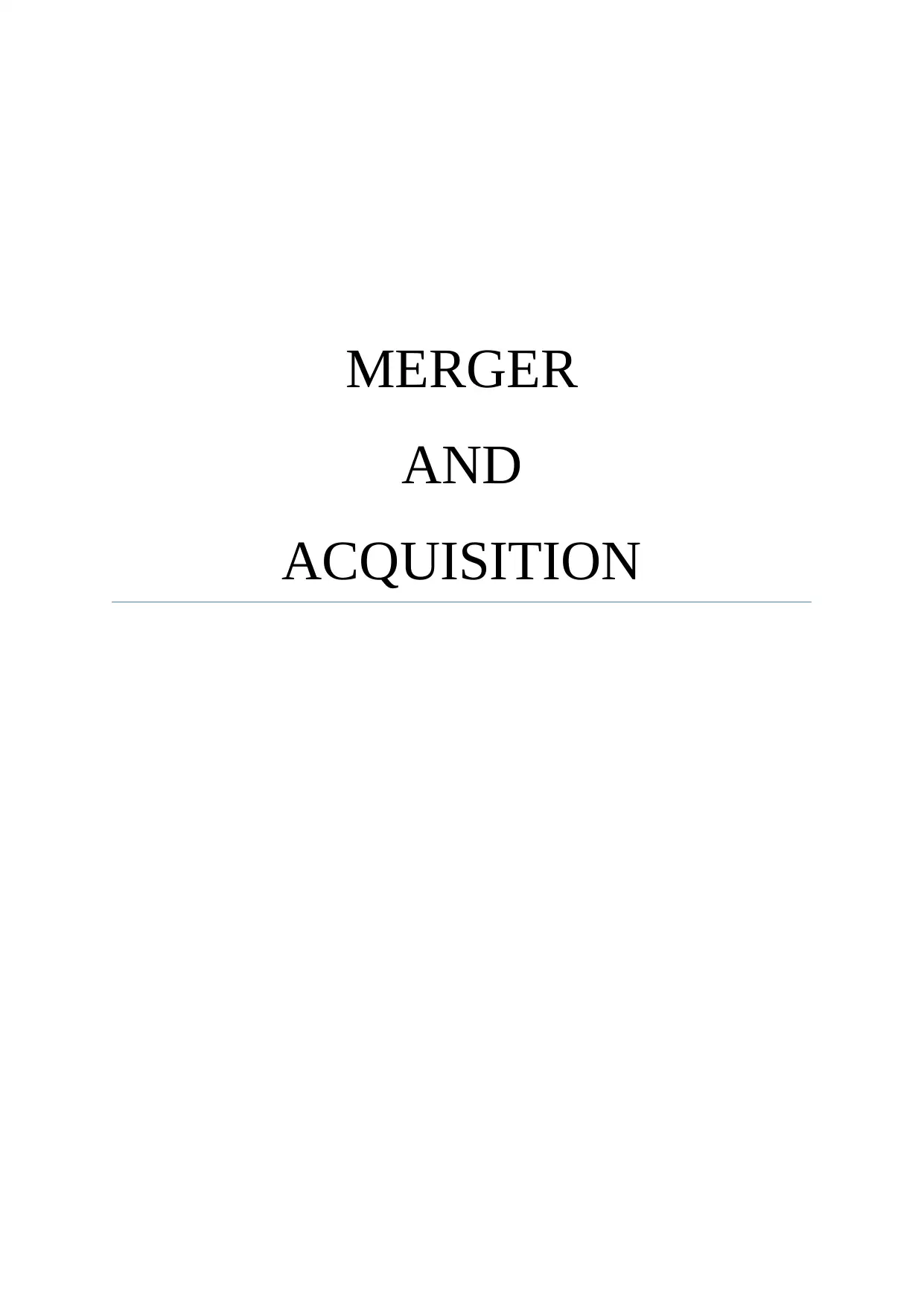
MERGER
AND
ACQUISITION
AND
ACQUISITION
Paraphrase This Document
Need a fresh take? Get an instant paraphrase of this document with our AI Paraphraser
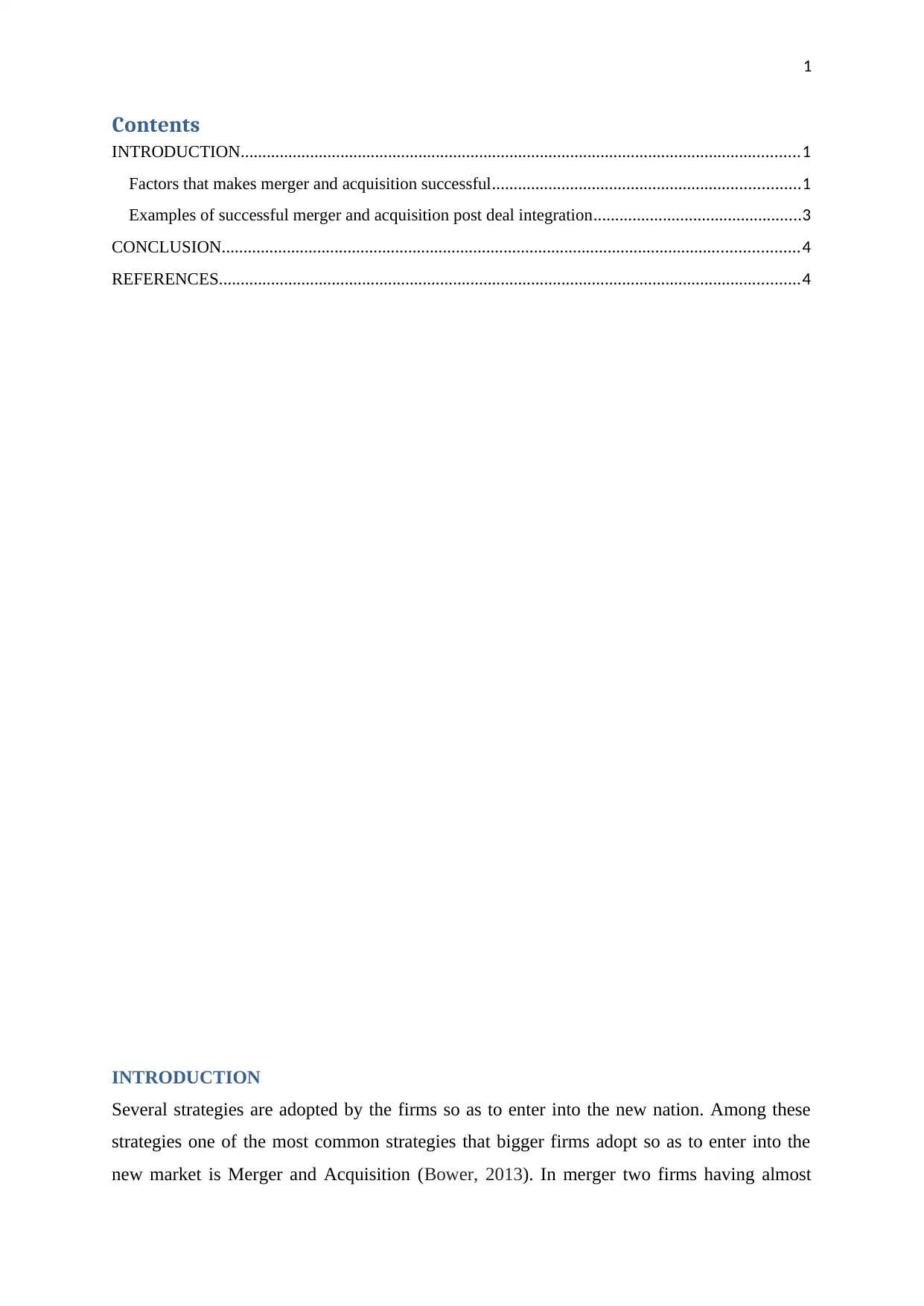
1
Contents
INTRODUCTION.................................................................................................................................1
Factors that makes merger and acquisition successful.......................................................................1
Examples of successful merger and acquisition post deal integration................................................3
CONCLUSION.....................................................................................................................................4
REFERENCES......................................................................................................................................4
INTRODUCTION
Several strategies are adopted by the firms so as to enter into the new nation. Among these
strategies one of the most common strategies that bigger firms adopt so as to enter into the
new market is Merger and Acquisition (Bower, 2013). In merger two firms having almost
Contents
INTRODUCTION.................................................................................................................................1
Factors that makes merger and acquisition successful.......................................................................1
Examples of successful merger and acquisition post deal integration................................................3
CONCLUSION.....................................................................................................................................4
REFERENCES......................................................................................................................................4
INTRODUCTION
Several strategies are adopted by the firms so as to enter into the new nation. Among these
strategies one of the most common strategies that bigger firms adopt so as to enter into the
new market is Merger and Acquisition (Bower, 2013). In merger two firms having almost
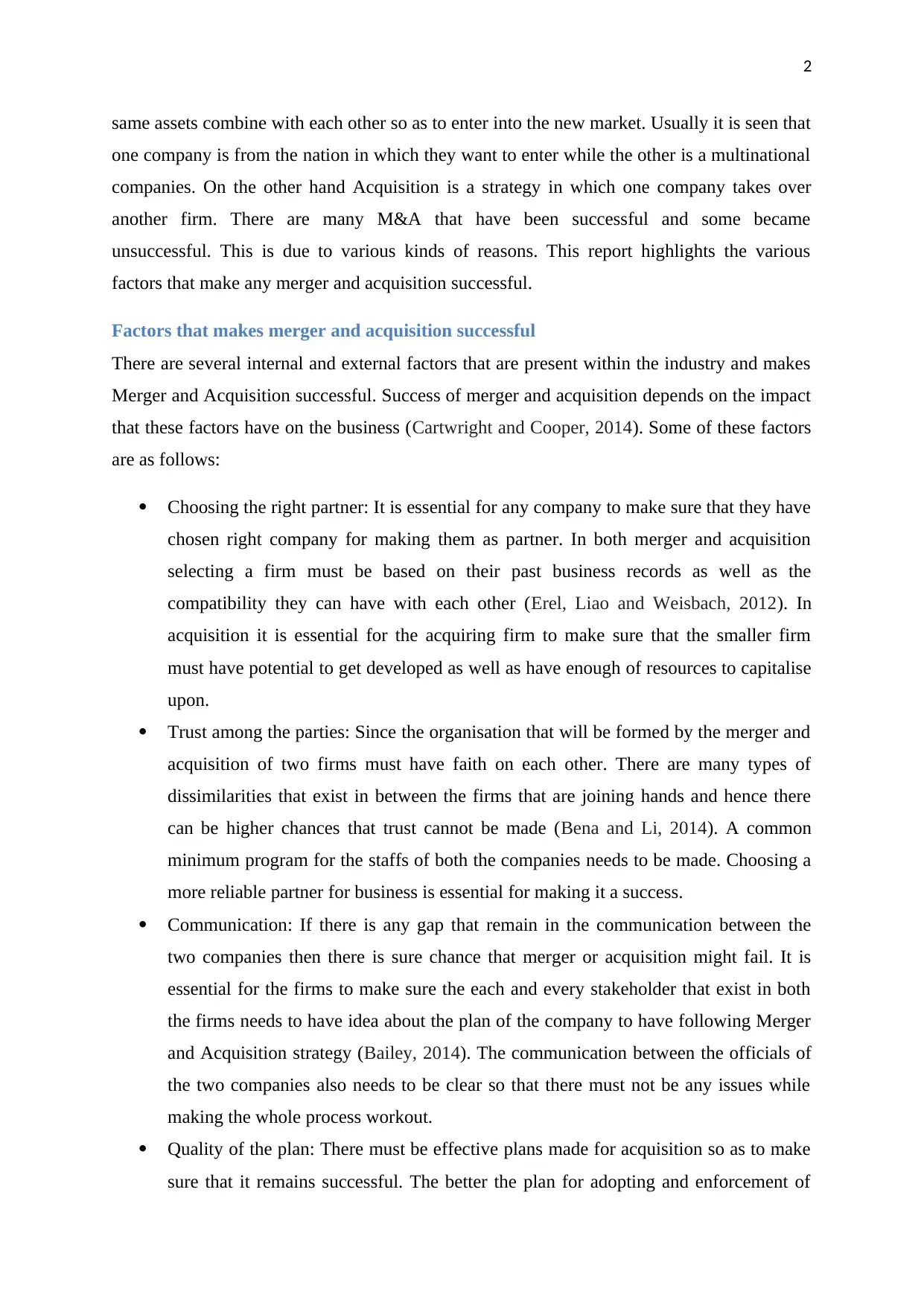
2
same assets combine with each other so as to enter into the new market. Usually it is seen that
one company is from the nation in which they want to enter while the other is a multinational
companies. On the other hand Acquisition is a strategy in which one company takes over
another firm. There are many M&A that have been successful and some became
unsuccessful. This is due to various kinds of reasons. This report highlights the various
factors that make any merger and acquisition successful.
Factors that makes merger and acquisition successful
There are several internal and external factors that are present within the industry and makes
Merger and Acquisition successful. Success of merger and acquisition depends on the impact
that these factors have on the business (Cartwright and Cooper, 2014). Some of these factors
are as follows:
Choosing the right partner: It is essential for any company to make sure that they have
chosen right company for making them as partner. In both merger and acquisition
selecting a firm must be based on their past business records as well as the
compatibility they can have with each other (Erel, Liao and Weisbach, 2012). In
acquisition it is essential for the acquiring firm to make sure that the smaller firm
must have potential to get developed as well as have enough of resources to capitalise
upon.
Trust among the parties: Since the organisation that will be formed by the merger and
acquisition of two firms must have faith on each other. There are many types of
dissimilarities that exist in between the firms that are joining hands and hence there
can be higher chances that trust cannot be made (Bena and Li, 2014). A common
minimum program for the staffs of both the companies needs to be made. Choosing a
more reliable partner for business is essential for making it a success.
Communication: If there is any gap that remain in the communication between the
two companies then there is sure chance that merger or acquisition might fail. It is
essential for the firms to make sure the each and every stakeholder that exist in both
the firms needs to have idea about the plan of the company to have following Merger
and Acquisition strategy (Bailey, 2014). The communication between the officials of
the two companies also needs to be clear so that there must not be any issues while
making the whole process workout.
Quality of the plan: There must be effective plans made for acquisition so as to make
sure that it remains successful. The better the plan for adopting and enforcement of
same assets combine with each other so as to enter into the new market. Usually it is seen that
one company is from the nation in which they want to enter while the other is a multinational
companies. On the other hand Acquisition is a strategy in which one company takes over
another firm. There are many M&A that have been successful and some became
unsuccessful. This is due to various kinds of reasons. This report highlights the various
factors that make any merger and acquisition successful.
Factors that makes merger and acquisition successful
There are several internal and external factors that are present within the industry and makes
Merger and Acquisition successful. Success of merger and acquisition depends on the impact
that these factors have on the business (Cartwright and Cooper, 2014). Some of these factors
are as follows:
Choosing the right partner: It is essential for any company to make sure that they have
chosen right company for making them as partner. In both merger and acquisition
selecting a firm must be based on their past business records as well as the
compatibility they can have with each other (Erel, Liao and Weisbach, 2012). In
acquisition it is essential for the acquiring firm to make sure that the smaller firm
must have potential to get developed as well as have enough of resources to capitalise
upon.
Trust among the parties: Since the organisation that will be formed by the merger and
acquisition of two firms must have faith on each other. There are many types of
dissimilarities that exist in between the firms that are joining hands and hence there
can be higher chances that trust cannot be made (Bena and Li, 2014). A common
minimum program for the staffs of both the companies needs to be made. Choosing a
more reliable partner for business is essential for making it a success.
Communication: If there is any gap that remain in the communication between the
two companies then there is sure chance that merger or acquisition might fail. It is
essential for the firms to make sure the each and every stakeholder that exist in both
the firms needs to have idea about the plan of the company to have following Merger
and Acquisition strategy (Bailey, 2014). The communication between the officials of
the two companies also needs to be clear so that there must not be any issues while
making the whole process workout.
Quality of the plan: There must be effective plans made for acquisition so as to make
sure that it remains successful. The better the plan for adopting and enforcement of
⊘ This is a preview!⊘
Do you want full access?
Subscribe today to unlock all pages.

Trusted by 1+ million students worldwide
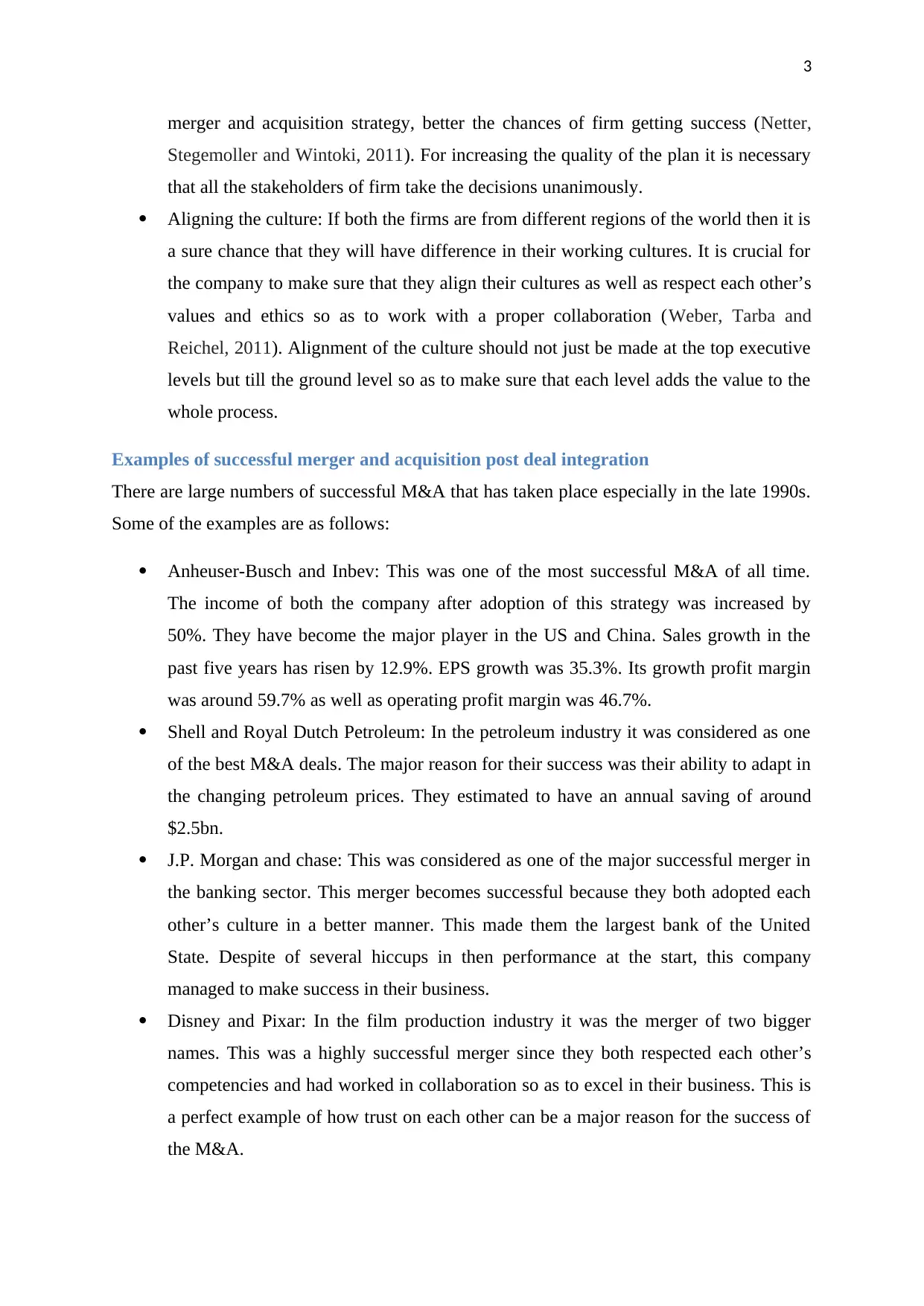
3
merger and acquisition strategy, better the chances of firm getting success (Netter,
Stegemoller and Wintoki, 2011). For increasing the quality of the plan it is necessary
that all the stakeholders of firm take the decisions unanimously.
Aligning the culture: If both the firms are from different regions of the world then it is
a sure chance that they will have difference in their working cultures. It is crucial for
the company to make sure that they align their cultures as well as respect each other’s
values and ethics so as to work with a proper collaboration (Weber, Tarba and
Reichel, 2011). Alignment of the culture should not just be made at the top executive
levels but till the ground level so as to make sure that each level adds the value to the
whole process.
Examples of successful merger and acquisition post deal integration
There are large numbers of successful M&A that has taken place especially in the late 1990s.
Some of the examples are as follows:
Anheuser-Busch and Inbev: This was one of the most successful M&A of all time.
The income of both the company after adoption of this strategy was increased by
50%. They have become the major player in the US and China. Sales growth in the
past five years has risen by 12.9%. EPS growth was 35.3%. Its growth profit margin
was around 59.7% as well as operating profit margin was 46.7%.
Shell and Royal Dutch Petroleum: In the petroleum industry it was considered as one
of the best M&A deals. The major reason for their success was their ability to adapt in
the changing petroleum prices. They estimated to have an annual saving of around
$2.5bn.
J.P. Morgan and chase: This was considered as one of the major successful merger in
the banking sector. This merger becomes successful because they both adopted each
other’s culture in a better manner. This made them the largest bank of the United
State. Despite of several hiccups in then performance at the start, this company
managed to make success in their business.
Disney and Pixar: In the film production industry it was the merger of two bigger
names. This was a highly successful merger since they both respected each other’s
competencies and had worked in collaboration so as to excel in their business. This is
a perfect example of how trust on each other can be a major reason for the success of
the M&A.
merger and acquisition strategy, better the chances of firm getting success (Netter,
Stegemoller and Wintoki, 2011). For increasing the quality of the plan it is necessary
that all the stakeholders of firm take the decisions unanimously.
Aligning the culture: If both the firms are from different regions of the world then it is
a sure chance that they will have difference in their working cultures. It is crucial for
the company to make sure that they align their cultures as well as respect each other’s
values and ethics so as to work with a proper collaboration (Weber, Tarba and
Reichel, 2011). Alignment of the culture should not just be made at the top executive
levels but till the ground level so as to make sure that each level adds the value to the
whole process.
Examples of successful merger and acquisition post deal integration
There are large numbers of successful M&A that has taken place especially in the late 1990s.
Some of the examples are as follows:
Anheuser-Busch and Inbev: This was one of the most successful M&A of all time.
The income of both the company after adoption of this strategy was increased by
50%. They have become the major player in the US and China. Sales growth in the
past five years has risen by 12.9%. EPS growth was 35.3%. Its growth profit margin
was around 59.7% as well as operating profit margin was 46.7%.
Shell and Royal Dutch Petroleum: In the petroleum industry it was considered as one
of the best M&A deals. The major reason for their success was their ability to adapt in
the changing petroleum prices. They estimated to have an annual saving of around
$2.5bn.
J.P. Morgan and chase: This was considered as one of the major successful merger in
the banking sector. This merger becomes successful because they both adopted each
other’s culture in a better manner. This made them the largest bank of the United
State. Despite of several hiccups in then performance at the start, this company
managed to make success in their business.
Disney and Pixar: In the film production industry it was the merger of two bigger
names. This was a highly successful merger since they both respected each other’s
competencies and had worked in collaboration so as to excel in their business. This is
a perfect example of how trust on each other can be a major reason for the success of
the M&A.
Paraphrase This Document
Need a fresh take? Get an instant paraphrase of this document with our AI Paraphraser
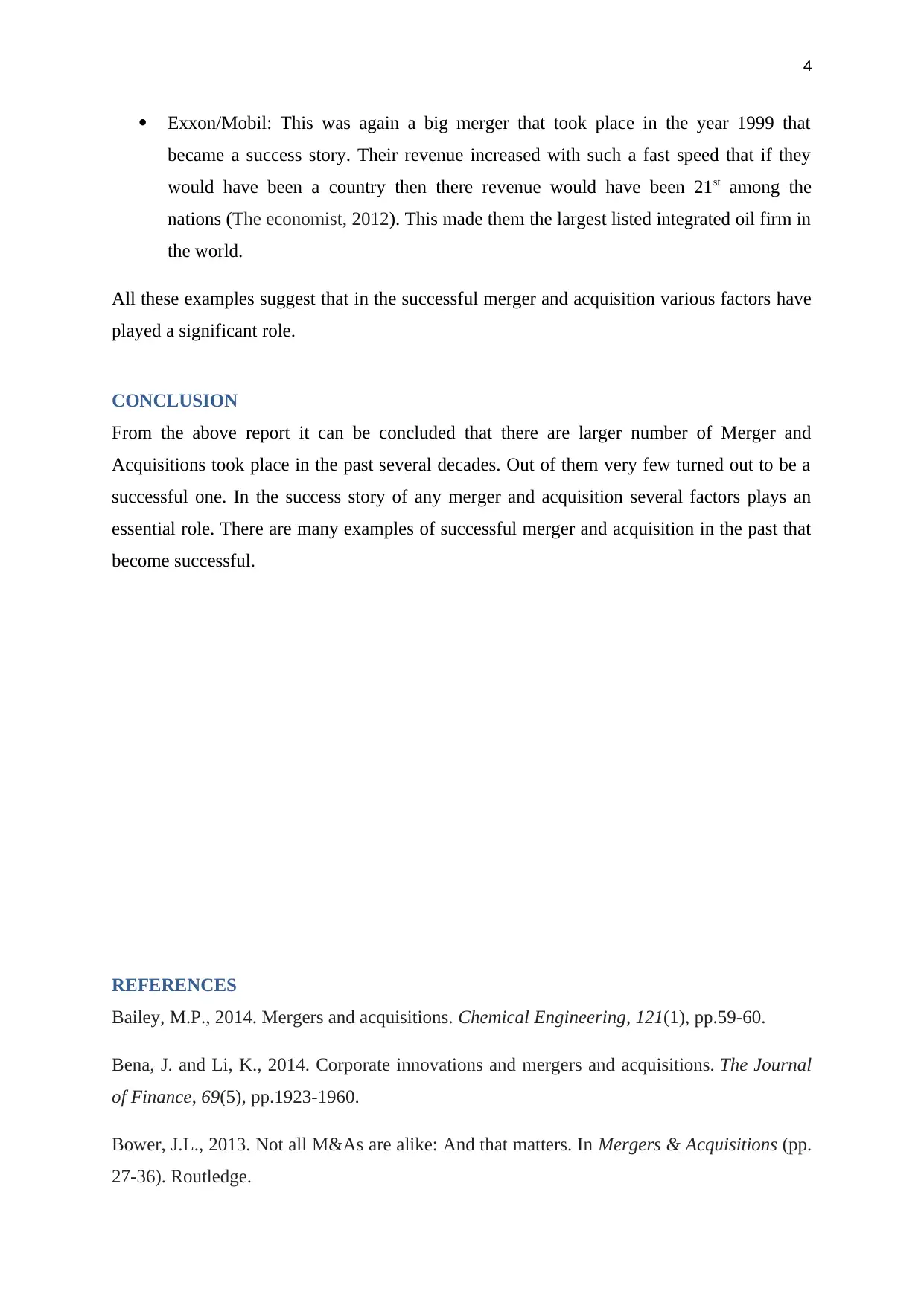
4
Exxon/Mobil: This was again a big merger that took place in the year 1999 that
became a success story. Their revenue increased with such a fast speed that if they
would have been a country then there revenue would have been 21st among the
nations (The economist, 2012). This made them the largest listed integrated oil firm in
the world.
All these examples suggest that in the successful merger and acquisition various factors have
played a significant role.
CONCLUSION
From the above report it can be concluded that there are larger number of Merger and
Acquisitions took place in the past several decades. Out of them very few turned out to be a
successful one. In the success story of any merger and acquisition several factors plays an
essential role. There are many examples of successful merger and acquisition in the past that
become successful.
REFERENCES
Bailey, M.P., 2014. Mergers and acquisitions. Chemical Engineering, 121(1), pp.59-60.
Bena, J. and Li, K., 2014. Corporate innovations and mergers and acquisitions. The Journal
of Finance, 69(5), pp.1923-1960.
Bower, J.L., 2013. Not all M&As are alike: And that matters. In Mergers & Acquisitions (pp.
27-36). Routledge.
Exxon/Mobil: This was again a big merger that took place in the year 1999 that
became a success story. Their revenue increased with such a fast speed that if they
would have been a country then there revenue would have been 21st among the
nations (The economist, 2012). This made them the largest listed integrated oil firm in
the world.
All these examples suggest that in the successful merger and acquisition various factors have
played a significant role.
CONCLUSION
From the above report it can be concluded that there are larger number of Merger and
Acquisitions took place in the past several decades. Out of them very few turned out to be a
successful one. In the success story of any merger and acquisition several factors plays an
essential role. There are many examples of successful merger and acquisition in the past that
become successful.
REFERENCES
Bailey, M.P., 2014. Mergers and acquisitions. Chemical Engineering, 121(1), pp.59-60.
Bena, J. and Li, K., 2014. Corporate innovations and mergers and acquisitions. The Journal
of Finance, 69(5), pp.1923-1960.
Bower, J.L., 2013. Not all M&As are alike: And that matters. In Mergers & Acquisitions (pp.
27-36). Routledge.
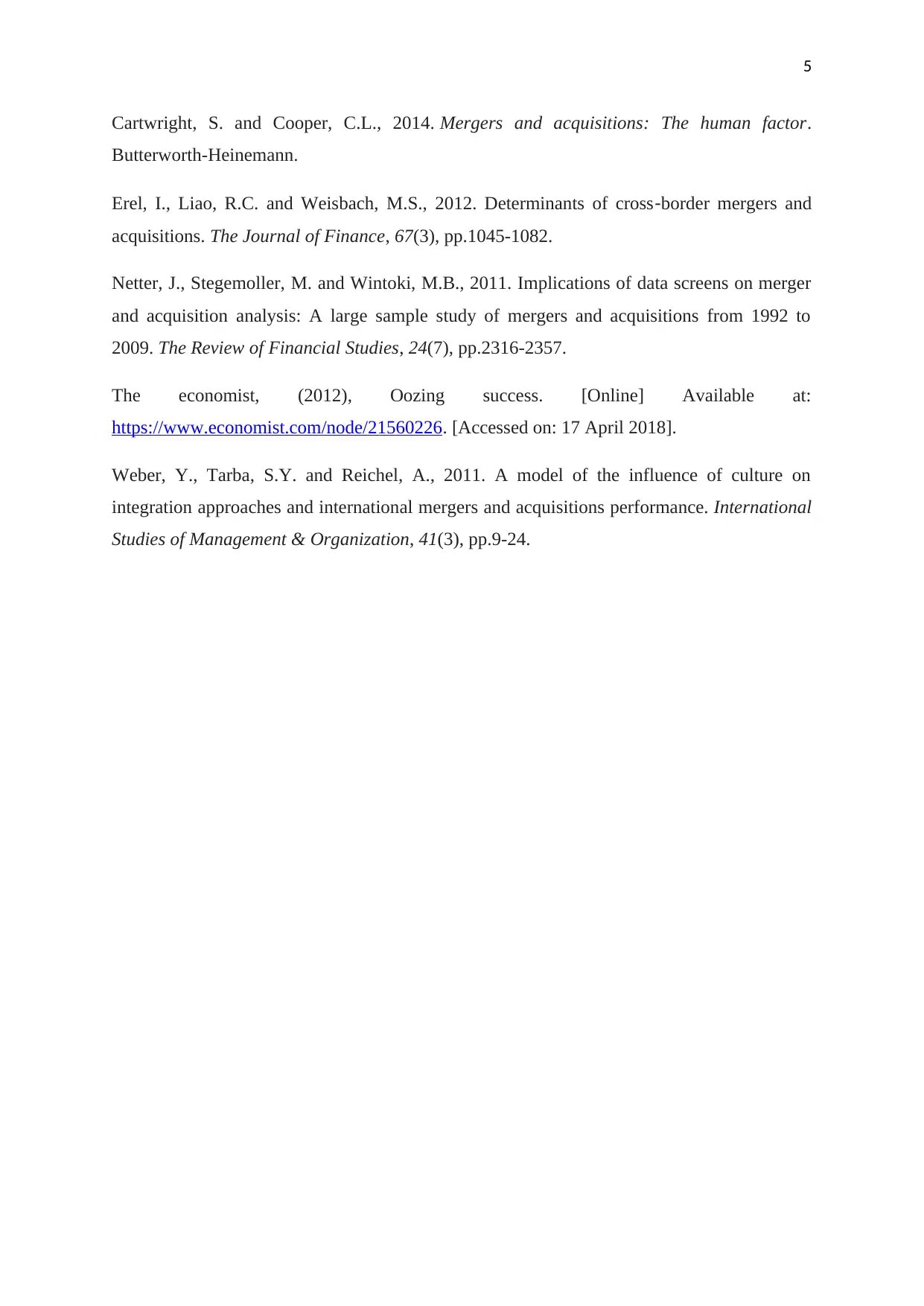
5
Cartwright, S. and Cooper, C.L., 2014. Mergers and acquisitions: The human factor.
Butterworth-Heinemann.
Erel, I., Liao, R.C. and Weisbach, M.S., 2012. Determinants of cross‐border mergers and
acquisitions. The Journal of Finance, 67(3), pp.1045-1082.
Netter, J., Stegemoller, M. and Wintoki, M.B., 2011. Implications of data screens on merger
and acquisition analysis: A large sample study of mergers and acquisitions from 1992 to
2009. The Review of Financial Studies, 24(7), pp.2316-2357.
The economist, (2012), Oozing success. [Online] Available at:
https://www.economist.com/node/21560226. [Accessed on: 17 April 2018].
Weber, Y., Tarba, S.Y. and Reichel, A., 2011. A model of the influence of culture on
integration approaches and international mergers and acquisitions performance. International
Studies of Management & Organization, 41(3), pp.9-24.
Cartwright, S. and Cooper, C.L., 2014. Mergers and acquisitions: The human factor.
Butterworth-Heinemann.
Erel, I., Liao, R.C. and Weisbach, M.S., 2012. Determinants of cross‐border mergers and
acquisitions. The Journal of Finance, 67(3), pp.1045-1082.
Netter, J., Stegemoller, M. and Wintoki, M.B., 2011. Implications of data screens on merger
and acquisition analysis: A large sample study of mergers and acquisitions from 1992 to
2009. The Review of Financial Studies, 24(7), pp.2316-2357.
The economist, (2012), Oozing success. [Online] Available at:
https://www.economist.com/node/21560226. [Accessed on: 17 April 2018].
Weber, Y., Tarba, S.Y. and Reichel, A., 2011. A model of the influence of culture on
integration approaches and international mergers and acquisitions performance. International
Studies of Management & Organization, 41(3), pp.9-24.
⊘ This is a preview!⊘
Do you want full access?
Subscribe today to unlock all pages.

Trusted by 1+ million students worldwide
1 out of 6
Related Documents
Your All-in-One AI-Powered Toolkit for Academic Success.
+13062052269
info@desklib.com
Available 24*7 on WhatsApp / Email
![[object Object]](/_next/static/media/star-bottom.7253800d.svg)
Unlock your academic potential
Copyright © 2020–2025 A2Z Services. All Rights Reserved. Developed and managed by ZUCOL.





